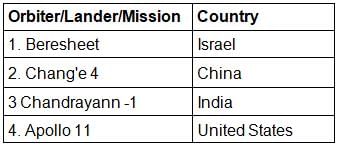Kerala PSC KAS Prelims Paper 2 Mock Test - 3 - Kerala PSC KAS MCQ
30 Questions MCQ Test Kerala PSC KAS Mock Test Series 2024 - Kerala PSC KAS Prelims Paper 2 Mock Test - 3
Consider the following statements about the Monetary Policy Committee:
It seeks to set targets for inflation in India.
Governor of the RBI is the ex-officio Chairperson of the Committee.
Which of the statements given above is/are not correct?
It seeks to set targets for inflation in India.
Governor of the RBI is the ex-officio Chairperson of the Committee.
Who received the prestigious Times Power Icon 2024 Award?
Which prestigious prize did Michel Talagrand win in 2024?
What notable achievement did the film "Bharat Maro Desh Che" accomplish?
What award did Bina Agarwal and James K. Boyce receive in 2024?
Which award did PM Modi receive from Bhutan?
Which company topped the Governance Now 10th PSU Awards with three awards?
What is the significance of the Raksha Mantri Trophy?
Who was awarded the Saraswati Samman for 2023?
What major award did Uday Bhatia and Manasi Gupta receive?
What recognition did Tata AIA receive in 2023?
Who was awarded the Sangita Kalanidhi award in 2024?
Which Indian airport was recognized as the best at arrival by Airports Council International?
What award did Ratan Tata receive for his philanthropic work?
Which of the following is/are responsible for demand-pull inflation ?
1. Increase in government spending
2. Increase in the unemployment rate
3. Increase in crude oil prices
Select the correct answer using the code given below :
With reference to the Indian Register of Shipping (IRS), consider the following statements:
1. It was established after the recommendation of the Mudaliar Committee.
2. It is an international ship classification society providing certification and technical inspection services.
Which of the statements given above is/are correct?
Regarding Skill Acquisition and Knowledge Awareness for Livelihood Promotion (“SANKALP”), consider the following statements:
1. It is a Centrally sponsored scheme with loan assistance from the International Monetary Fund (IMF) .
2. It is a placement linked skill development scheme for rural poor youth under National Rural Livelihoods Mission (NRLM).
Which of the statements given above is/are correct?
Which among the following is the objective of ‘Mera Bill Mera Adhikaar’ scheme?
It is an agency of the Union Ministry of Commerce and Industry, established in 1991 and is responsible for administering laws regarding foreign trade and foreign investment in India and for the execution of India’s import and export Policy. It offers facilitation to exporters in connection with developments in international trade such as WTO Agreements, Rules of Origin etc.
Which of the following bodies has been described above?
Consider the following statements regarding Consumer Price Index (CPI):
1. It captures the average movement of wholesale prices of goods and is primarily used as a GDP deflator.
2. It is calculated for a fixed list of items including food, housing, apparel, transportation, electronics, medical care, education, etc.
Which of the statements given above is/are correct?
Loans to which of the following sectors are eligible for consideration as loans under Priority Sector Lending?
Education
Renewable Energy
Housing
Agriculture
Select the correct answer using the code given below.
Which of the following industries are classified as the Core Industries in the Index of Industrial Production?
Coal
Automobiles
Electricity
Real Estate
Select the correct answer using the code given below.
In the context of socio-economic development in post-Independent India, Gadgil-Mukherjee Formula was introduced in which of the following context?
Consider the following statements with reference to Inflationary Gap:
It is the measure of the difference between the current level of real GDP and the GDP of the economy operating at full employment level.
Inflationary gap is the result of a deficiency in demand.
Which of the statements given above is/are correct?
With reference to ‘Menstrual Hygiene for Adolescent Girls Scheme’, consider the following statements :
1. It aims to improve access to and use of high- quality sanitary napkins by adolescent girls in rural areas.
2. Under this scheme funds will be provided to ASHAs to hold monthly meeting with adolescents to discuss issues related to menstrual hygiene.
3. It also ensures the safe disposal of Sanitary Napkins in an environmentally friendly manner.
Which of the statements given above is/are Correct?
Which of the following sets of pair(s) is/are correctly matched?

Select the correct answer using the code given below:
With reference to ‘The Human body’, consider the following statements:
1. Human skeleton is composed of around 305 bones at birth.
2. Our palm and fingers consists of many small bones called Carpels.
3. Our Lungs are protected between the chest bone and backbone.
Which of the statements given above is/are Correct?
With reference to microbes in sewage treatment, consider the following statements:
1. ‘Flocs’ are masses of aerobic bacteria that are used for consuming the organic matter in the sewage waste.
2. Flocs increase the Biological Oxygen Demand of the sewage.
3. ‘Activated sludge’ is free from bacteria and other microorganisms.
Which of the statements given above is/are Correct?
Which of the following can be a potential carcinogenic factor?
1. Ionizing radiation (X-rays)
2. Non- Ionizing radiation (UV-rays)
3. Human Papillomavirus (HPV)
Select the correct answer from the codes given Below
Clotting of the blood is formed because of the presence of which of the following cells:


















